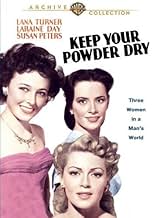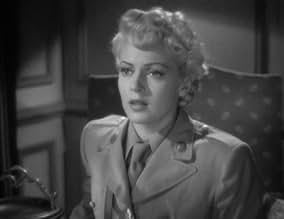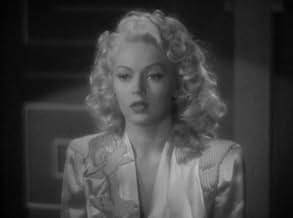Füge eine Handlung in deiner Sprache hinzuA disparate group of women try to adjust to their new lives after enlisting in the Women's Army Corps.A disparate group of women try to adjust to their new lives after enlisting in the Women's Army Corps.A disparate group of women try to adjust to their new lives after enlisting in the Women's Army Corps.
- Regie
- Drehbuch
- Hauptbesetzung
Empfohlene Bewertungen
I recently saw this on TCM and had never seen it before. Director Edward Buzzell had a career in 30's and 40's films that were mostly actress driven romantic comedies before he made the leap to television in the early 50's. He also directed a couple of Marx Brothers movies. Here he is in his element directing three talented actress. Lana Turner is Val Parks, a playgirl heiress who is being forced to join the Women's Army Corp by her family before she can get her hands on any more of the family fortune. Larraine Day is Napoleon Rand, an army brat who knows the military rules book by heart and becomes a WAC to carry on a family tradition. Susan Peters is Annie Darrison, the wife of an army officer fighting in WWII. Parks and Rand instantly develop a dislike for each other and Darrison becomes the mediator as all three are assigned as mechanics in the same unit. What makes for believable on-screen tension between the Turner and Day characters is that they couldn't stand each other in real life. Day had billing over Turner in the only other film they appeared in, 1939's Calling Dr. Kildare when Turner was an upcoming starlet. By the time filming started on this movie in August of 1944 Turner was an established star and had billing above Day. Day was icy to Turner in 1939 and Turner returned the cold shoulder in 1944. Susan Peters is one of Hollywood's tragic figures. She lost her father in an accident as a young girl and never got over it. Her acting career got off to a rocky start and was dropped by Warner Brothers but MGM saw something promising and she had earned an Academy Award nomination for Random Harvest. A miscarriage kept her off the screen just when her career was at it's brightest and she returned to the screen for this film but less than two months after filming she was shot in a hunting accident and paralyzed from the waist down. She made an attempt in limited roles to keep acting on screen, stage and television but depression led to her divorcing her husband and becoming recluse and anorexia nervosa led to her death at age 31. The Cedric Gibbins MGM art direction team on this film features 8 time Oscar winner Edwin Willis as set director. Proliffic cinematographer Ray June is the films photographer but the soft focus closeups are so overboard they are almost laughable. Some corny, silly dialog and situations but actually it isn't too bad of a movie. A female version of a WWII buddy movie. Agnes Moorehead, Natalie Schafer and June Lockhart in supporting roles. It's worth a look and I would give it a 6.5 out of 10.
The unlikely prospect of anyone who looks like Lana Turner giving up her comfy civilian life to wear an army uniform is the hardest thing to swallow about this service film about three women from different walks of life who learn to become army buddies. Turner, of course, is given the glamour treatment and must have made hundreds of girls think they would look terrific in khaki.
Nevertheless, it's an enjoyable enough item sparked by some very competent performances by the mostly female cast. It's the feminine prototype of countless serviceman films produced during the war years of World War II, given non-serious treatment with a story centering on three new WAC recruits. Laraine Day plays an army brat, a girl who constantly flaunts her superiority over the other recruits and for most of the film engages in a tug of war with Turner. While Turner was given the full glamour treatment, Laraine Day succeeded in playing her unsympathetic role to the hilt, for the first time showing a harder edge to her screen personality. The film is enjoyable fluff, with good work by Susan Peters and Agnes Moorehead.
My article on Laraine Day appears in the Spring 2001 issue of FILMS OF THE GOLDEN AGE--and one on Lana Turner is due for publication at a later date.
Nevertheless, it's an enjoyable enough item sparked by some very competent performances by the mostly female cast. It's the feminine prototype of countless serviceman films produced during the war years of World War II, given non-serious treatment with a story centering on three new WAC recruits. Laraine Day plays an army brat, a girl who constantly flaunts her superiority over the other recruits and for most of the film engages in a tug of war with Turner. While Turner was given the full glamour treatment, Laraine Day succeeded in playing her unsympathetic role to the hilt, for the first time showing a harder edge to her screen personality. The film is enjoyable fluff, with good work by Susan Peters and Agnes Moorehead.
My article on Laraine Day appears in the Spring 2001 issue of FILMS OF THE GOLDEN AGE--and one on Lana Turner is due for publication at a later date.
-- but Natalie Schafer plays a wealthy, mindless socialite!
If the ending doesn't draw at least a couple tears from your eye, especially these days, then you're heartless. Bah.
If you like this sort of movie (as do I), you will definitely enjoy this particular example of it. Very well done.
My only regret is that they didn't show enough of the training. Having gone through OCS myself, it's such an overwhelming, life-changing experience (though I don't know about the WACs' OCS) that it was a bit of a cheat that we didn't get to see how it changed the girls, only that it did. I suspect the writer was more concerned about the dynamic between the three main characters, rather than the interaction between each of them and the demands of officer candidate school.
Dafydd ab Hugh
If the ending doesn't draw at least a couple tears from your eye, especially these days, then you're heartless. Bah.
If you like this sort of movie (as do I), you will definitely enjoy this particular example of it. Very well done.
My only regret is that they didn't show enough of the training. Having gone through OCS myself, it's such an overwhelming, life-changing experience (though I don't know about the WACs' OCS) that it was a bit of a cheat that we didn't get to see how it changed the girls, only that it did. I suspect the writer was more concerned about the dynamic between the three main characters, rather than the interaction between each of them and the demands of officer candidate school.
Dafydd ab Hugh
It seems that the film boards made a concerted effort to boost the image of women as tough and capable leading up to and continuing through World War II. "Keep Your Powder Dry" is an effort to display three women who overcome their disparate backgrounds, their petty differences, and their civilian prejudices to achieve a greater good by contributing to the war effort. A character in the film puts it this way, "...subordinate your personal feelings for the good of the corps."
This is a consistent theme in movies throughout this era. In John Ford's "Pearl Harbor" a German mocks the notion that the weak and decadent American women could take the place of men in industry to free them for service as soldiers. In "Cry Havoc" we witness the courage, trials, and sacrifices of women on Corregidor. Here in "Keep Your Powder Dry" we learn of the candidates' perseverance through the trials of boot camp, motor pool training, and OCS school (though the examples that they show are weak).
It is a little difficult to suspend reality far enough to buy the notion that Lana Turner could become dedicated to life in the WACs, having arrived by way of Park Avenue, but an effort is made by the screenwriter to show her recognition of the shallow and narcissistic lifestyle that she found there. It occurs rather late in the film, however.
Still, for WWII movie buffs, and fans for the movies of the forties, this one is a must see.
This is a consistent theme in movies throughout this era. In John Ford's "Pearl Harbor" a German mocks the notion that the weak and decadent American women could take the place of men in industry to free them for service as soldiers. In "Cry Havoc" we witness the courage, trials, and sacrifices of women on Corregidor. Here in "Keep Your Powder Dry" we learn of the candidates' perseverance through the trials of boot camp, motor pool training, and OCS school (though the examples that they show are weak).
It is a little difficult to suspend reality far enough to buy the notion that Lana Turner could become dedicated to life in the WACs, having arrived by way of Park Avenue, but an effort is made by the screenwriter to show her recognition of the shallow and narcissistic lifestyle that she found there. It occurs rather late in the film, however.
Still, for WWII movie buffs, and fans for the movies of the forties, this one is a must see.
Tidy little drama with some comic overtones. Lana, looking lovely in her first turn after giving birth to daughter Cheryl the year before, is a playgirl who the corps teaches the value of hard work and focus. Laraine the army brat who has to learn to lighten up and actually relate to people and Susan Peters, in her last role before the shooting accident that crippled her and more or less ended her career, the spunky young bride who plays peacemaker between them. All three give good performances in what is basically a recruitment poster for the war effort with a little soap mixed in, and a highly enjoyable one at that.
The three girls are basically the whole show but they are supported by some fine performers. Agnes Moorehead is all stiff upper lip in her small role as the commanding officer although she manages to mix in some warmth too. Natalie Schafer is very chic as one of Lana's fair weather friends in civilian life and in a small role as another sycophant is Jess Barker, who at the time was Susan Hayward's husband. The real standout is Lee Patrick as a former showgirl, she's sassy and brassy who adds a light touch to her scenes which is most welcome.
The three girls are basically the whole show but they are supported by some fine performers. Agnes Moorehead is all stiff upper lip in her small role as the commanding officer although she manages to mix in some warmth too. Natalie Schafer is very chic as one of Lana's fair weather friends in civilian life and in a small role as another sycophant is Jess Barker, who at the time was Susan Hayward's husband. The real standout is Lee Patrick as a former showgirl, she's sassy and brassy who adds a light touch to her scenes which is most welcome.
Wusstest du schon
- WissenswertesLana Turner wrote in her 1982 autobiography that during pre-production she received a studio memo of reprimand about missing many of her wardrobe appointments--even though it was Irene who was not showing up. When Turner went to studio head Louis B. Mayer to defend herself, she was told that the memo was a face-saving device for Irene, who was an alcoholic but so valuable to MGM that the studio was willing to bear with her problems and delays.
- PatzerWhen the WACs are on a long march with cadence, they are marching six abreast. The camera pans closer to them, and they are now four abreast.
- Zitate
Lt. Col. Spottiswoode: I'm sorry for you Rand, you've worked so hard to learn so many things so badly.
- VerbindungenReferenced in Lou Grant: Hollywood (1979)
- SoundtracksYou're In The Army Now
(1917) (uncredited)
Music by Isham Jones
Lyrics by Tell Taylor and Ole Olsen
Played during the opening credits
Top-Auswahl
Melde dich zum Bewerten an und greife auf die Watchlist für personalisierte Empfehlungen zu.
- How long is Keep Your Powder Dry?Powered by Alexa
Details
- Erscheinungsdatum
- Herkunftsland
- Sprache
- Auch bekannt als
- There Were Three of Us
- Drehorte
- Produktionsfirma
- Weitere beteiligte Unternehmen bei IMDbPro anzeigen
Box Office
- Budget
- 1.348.000 $ (geschätzt)
- Laufzeit1 Stunde 33 Minuten
- Farbe
- Seitenverhältnis
- 1.37 : 1
Zu dieser Seite beitragen
Bearbeitung vorschlagen oder fehlenden Inhalt hinzufügen

Oberste Lücke
By what name was Keep Your Powder Dry (1945) officially released in India in English?
Antwort


































